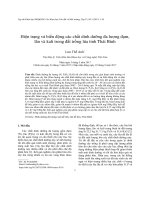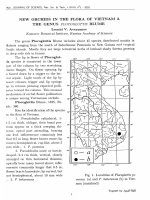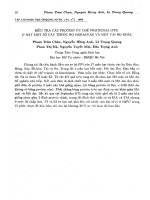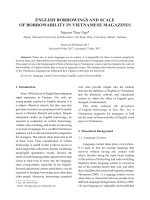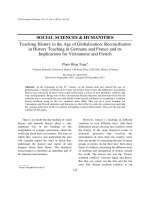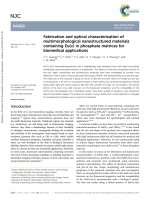DSpace at VNU: Divalent manganese in A-position of perovskite cell: X-ray absorption finite structure study of La(0.6)Sr(0.4-x)MnTi(x)O(3) manganites
Bạn đang xem bản rút gọn của tài liệu. Xem và tải ngay bản đầy đủ của tài liệu tại đây (499.21 KB, 4 trang )
Divalent manganese in A -position of perovskite cell: X-ray absorption finite structure
study of La 0.6 Sr 0.4 − x Mn Ti x O 3 manganites
A. N. Ulyanov, D. S. Yang, N. Chau, S. C. Yu, and S. I. Yoo
Citation: Journal of Applied Physics 103, 07F722 (2008); doi: 10.1063/1.2839318
View online: />View Table of Contents: />Published by the AIP Publishing
Articles you may be interested in
Rietveld fitting of x-ray diffraction spectra for the double phase composites La 0.7 − x Sr 0.3 Mn 1 − y O 3 − 1.5 (
x + y ) / ( Mn 3 O 4 ) y / 3
J. Appl. Phys. 105, 013905 (2009); 10.1063/1.3054355
Observation of 300 K high energy magnetodielectric contrast in the bilayer manganite ( La 0.4 Pr 0.6 ) 1.2 Sr 1.8
Mn 2 O 7
Appl. Phys. Lett. 91, 021913 (2007); 10.1063/1.2757120
Electronic and magnetic phase diagram of La 0.5 Sr 0.5 Co 1 − x Fe x O 3 ( 0 x 0.6 ) perovskites
J. Appl. Phys. 97, 10A508 (2005); 10.1063/1.1855197
Structural, magnetic, and transport properties in La0.7Ca0.3Mn1−xScxO3
J. Appl. Phys. 90, 4609 (2001); 10.1063/1.1405833
Lattice effects on the magnetic and transport properties of La 0.67−x Sm x Sr 0.33 CoO 3 perovskites
Appl. Phys. Lett. 75, 1772 (1999); 10.1063/1.124815
[This article is copyrighted as indicated in the article. Reuse of AIP content is subject to the terms at: Downloaded to ] IP:
137.99.31.134 On: Thu, 09 Oct 2014 23:28:42
JOURNAL OF APPLIED PHYSICS 103, 07F722 ͑2008͒
Divalent manganese in A-position of perovskite cell: X-ray absorption finite
structure study of La0.6Sr0.4−xMnTixO3 manganites
A. N. Ulyanov,1,a͒,b͒ D. S. Yang,2 N. Chau,3 S. C. Yu,4 and S. I. Yoo1,a͒,c͒
1
Department of Materials Science and Engineering, Seoul National University, Seoul 151-744,
Republic of Korea
2
Physics Division, School of Science Education, Chungbuk National University, Cheongju 361-763,
Republic of Korea
3
Center for Materials Science, National University of Hanoi, 334 Nguyen Trai, Hanoi, Vietnam
4
Department of Physics, Chungbuk National University, Cheongju 361-763, Republic of Korea
͑Presented on 8 November 2007; received 12 September 2007; accepted 10 December 2007;
published online 28 February 2008͒
Local structure and magnetic properties of Ti doped A-site deficient La0.6Sr0.4−xMnTixO3+␦
¯ c phase.
manganites ͑0.15ജ x ജ 0͒ have been studied. The compositions belong to rhombohedral R3
Segregation of ͑La0.6Sr0.4−xMny͒͑Mn1−y−zTix͒O3+␦ phase and fallout of ͑z / 3͒Mn3O4 oxide was
observed with x increase. Some amount ͑y͒ of Mn, being in divalent valence state, occupies the
A ͑=La, Sr͒-position of perovskite cell. Samples with x = 0 and 0.05 are ferromagnetic with Curie
temperature TC = 350 and 172 K, respectively. Samples with x = 0.1 and 0.15 are in
spin͑cluster͒-glass states at low temperatures. © 2008 American Institute of Physics.
͓DOI: 10.1063/1.2839318͔
In the last decades, properties of perovskite such as
Ln1−⌬1R⌬1Mn1−⌬2M ⌬2O3 lanthanum manganites have attracted a growing attention because of their interesting properties and rich phase diagram, especially the colossal magnetoresistivity effect observed ͑Ln is a trivalent rare earth, Y; R
is a divalent alkali earth, Sn and Pb; and M is a transition
metal͒.1 The parent LaMnO3 compound is antiferromagnetic
insulator. Substitution of trivalent Ln3+ ion by divalent R2+
ion gives rise to a coexistence of Mn3+ and Mn4+ ions and, at
some hole doping level ͑⌬1͒, manganites become a conductive ferromagnetic materials. According to double exchange
͑DE͒ model,2 transfer of itinerant eg electrons between
neighboring Mn3+ and Mn4+ ions through O2− ions results in
ferromagnetic interaction due to the on site Hund’s coupling.
Ion size mismatch was introduced to explain the dependence
of Curie temperature ͑TC͒ on average ionic radius in A
͑=Ln, R͒-position of ABO3 perovskite cell.3 B ͑=Mn, M͒-site
doping by transition metals damages the traveling path of
itinerant eg electrons and changes both magnetic B – O – B
interaction, and B–O distances and B – O – B angles, thus, affecting the properties of perovskite manganites ͑e.g., see
Refs. 4–6 and references therein͒. The effect depends on size
and electron configuration of dopants. Deficiency of La
and/or Mn ions ͑or the oxygen excess ␦͒ in LaMnO3 composition also causes the appearance of Mn3+ – Mn4+ mixedvalence state.7–11 Such, the self-doped manganites exhibit
both ferromagnetic-paramagnetic and metal-insulator transitions. Properties of A- and B-site substituted manganites
have been accurately studied and characterized in literature.
At the same time, the self-doped compositions are less carefully investigated and their description contains some
vagueness.10,12,13 The problem is in the complexity of the
a͒
Authors to whom correspondence should be addressed.
Electronic mail: aគnគ
c͒
Electronic mail:
b͒
0021-8979/2008/103͑7͒/07F722/3/$23.00
self-doped manganites from the crystallochemistry point of
view; how the structure accommodates the nonstoichiometry
and vacancies. An early structural study of LaMnO3+␦ manganites showed no excess oxygen in the interstitial positions
of the perovskite cell.14 Instead, there were found appropriate
amounts of vacancies in both La and Mn sites, which indicated the cation deficient origin of the entire structure sceleton. Recent magnetic and structural study of La1−⌬1MnO3
͑0.3ജ ⌬1 ജ 0͒ showed a fallout of Mn3O4 oxide and segregation of vacancy-doped La0.9MnO3 phase with ⌬1
increase.7 The phase segregation explains the composition
independent magnetic properties of La1−⌬1MnO3 observed in
the wide, 0.3ജ ⌬1 ജ 0.1, range. According to Refs. 8 and 9,
the La1−⌬1MnO3 can accommodate vacancies up to ⌬1
= 0.125 and 0.13, respectively. Recently, in the crystallochemical characterization of vacancy-doped LaMnO3
samples with different La/ Mn ratios by neutron diffraction,
it was suggested that the occurrence of Mn ions at the La site
be at La/ MnϽ 1.10 At the same time, authors noted that the
samples’ local structure can be quite satisfactory refined in
any ͑with and without Mn in La sublattice͒ distribution models and without supporting additional evidence, it is impossible to choose the proper one. The Mn2+ ions were detected
in strontium deficiency Pr0.7Sr0.3−xMnO3 manganites by
nuclear magnetic resonance spectroscopy, but the location of
the ions was not determined.12 To explain the properties of
Nd-deficient Nd0.9−xCaxMnO3 compositions, it was hypothesized that a part of Nd ions can be substituted by Mn ions.13
To elucidate these peculiarities, we present the careful local
structure analysis of La0.6Sr0.4−xMnTixO3+␦ manganites. To
this end, we employed the x-ray absorption fine structure
͑XAFS͒ analysis, which gives the information for both the
neighborhood of XAFS atoms and their valence states.
Samples were synthesized and characterized as in Ref.
15. La0.6Sr0.4−xMnTixO3+␦ manganites ͑x = 0.0, 0.05, 0.1, and
0.15͒ were prepared by conventional solid state reaction
103, 07F722-1
© 2008 American Institute of Physics
[This article is copyrighted as indicated in the article. Reuse of AIP content is subject to the terms at: Downloaded to ] IP:
137.99.31.134 On: Thu, 09 Oct 2014 23:28:42
07F722-2
Ulyanov et al.
J. Appl. Phys. 103, 07F722 ͑2008͒
FIG. 2. ͑Color online͒ EXAFS spectra for La0.6Sr0.4−xMnTixO3+␦ manganites
͑x = 0.0, 0.05, 0.1, and 0.15͒, and linear combination ͑LinComb, dotted line͒
for 0.9La0.6Sr0.4MnO3 and ͑0.1/ 3͒Mn3O4. The x = 0 and LinComb lines almost coincide.
FIG. 1. ͑Color online͒ ͑a͒ XANES spectra and temperature dependencies of
magnetization ͑on the inset͒ for La0.6Sr0.4−xMnTixO3+␦ manganites ͑x = 0.0,
0.05, 0.1, and 0.15, from the right to the left͒. ͑b͒ XANES spectra for
La0.6Sr0.4MnO3 ͑x = 0͒ phase ͑solid line͒, and for linear combination ͑LinComb, dotted line͒ for 0.9La0.6Sr0.4MnO3 and ͑0.1/ 3͒Mn3O4. The x = 0 and
LinComb lines almost coincide. Figure also shows the XANES spectra for
La0.6Sr0.3MnTi0.1O3 ͑x = 0.1͒, LaMnO3, and Mn3O4 and MnO oxides.
method. According to powder x-ray Cu K␣ analysis ͓x-ray
diffraction ͑XRD͔͒ the samples belong to rhombohedral
¯ c͒ phase and contain ͑at x 0͒ small amount of Mn O
͑R3
3 4
impurity oxide. On the basis of the XRD data, the oxide
amount is estimated to be less than 5 wt % and no anomalies
in the magnetization data could be attributed to the impurity
phase.
Magnetization measurements were carried out with the
superconducting quantum interference device ͑Quantum Design MPMSXL͒ magnetometer. Curie temperature ͑TC͒, determined as an inflection point on temperature dependence of
magnetization, decreases dramatically from 350 to 172 K
with x increase from 0 to 0.05 ͑see inset of Fig. 1͒. It is
believed that compounds with higher x content are in
spin͑cluster͒-glass-like state at low temperatures and transition to paramagnetic state is observed at 120 and 100 K for
the x = 0.1 and 0.15 samples, respectively. Spin ͑cluster͒glass-like behavior of La0.6Sr0.4−xMnTixO3+␦ manganites
with x = 0.1 was also reported in Ref. 16. Topfer and
Goodenough17 also pointed out that lanthanum manganites
with small content of cation vacancies exhibit spin-glass behavior below the Curie point. Detailed discussion of these
features lie beyond the scope of present report and will be
published elsewhere.
XAFS experiments were performed at the 3C extended
x-ray absorption fine structure ͑EXAFS͒ beam line of Pohang Light Source ͑PLS͒ in Korea. PLS operates with electron energy of 2.5 GeV and maximum current of 230 mA.
X-rays were monochromatized by Si͑111͒ double-crystal
monochromator with energy resolution, ⌬E / E = 2 ϫ 10−4.
Higher harmonics were removed by a 15% detuning of the
crystal. XAFS spectra were obtained near the Mn K edge
͑6540 eV͒ in a fluorescence mode at room temperature.
XAFS represents EXAFS, and x-ray absorption near edge
structure ͑XANES͒ analysis. EXAFS gives information
about the local structure around central atoms. Electronic
configuration ͑valence͒ of the core Mn cations can be deduced with the XANES spectra, obtained directly by the normalization of absorption spectra.18
XANES ͑Fig. 1͒, EXAFS ͑Fig. 2͒, and Fourier transform
of EXAFS spectra ͑Fig. 3͒ show continuous change with x.
XANES spectra shift to lower energy and essentially
broaden with x. It is important to emphasize that XANES
spectra of La1−xCaxMnO3 compositions19,20 showed almost
the same shape with x and only shifted parallel to each other
with increasing of Ca contents. The shift of the absorption
edge from the lower to higher energy with x was caused by
the change of average Mn valence from 3+ ͑in LaMnO3͒ to
4+ ͑in CaMnO3͒. The main absorption for the Mn3+ ion ͑in
FIG. 3. ͑Color online͒ Fourier transform of EXAFS spectra for
La0.6Sr0.4−xMnTixO3+␦ compositions ͑x = 0.0, 0.05, 0.1, and 0.15͒, and linear
combination ͑LinComb, dotted line͒ for 0.9La0.6Sr0.4MnO3 and
͑0.1/ 3͒Mn3O4. The x = 0 and LinComb lines almost coincide.
[This article is copyrighted as indicated in the article. Reuse of AIP content is subject to the terms at: Downloaded to ] IP:
137.99.31.134 On: Thu, 09 Oct 2014 23:28:42
07F722-3
J. Appl. Phys. 103, 07F722 ͑2008͒
Ulyanov et al.
LaMnO3͒ was observed at the interval from
6550 to 6556 eV.
A very different picture has been observed in our
study ͑see Fig. 1, where XANES spectra for
La0.6Sr0.4−xMnTixO3+␦, MnO, and Mn3O4 are presented͒. The
spectrum for the La0.6Sr0.4MnO3 ͑x = 0͒ composition shows
almost the same shape and position as those in
La0.7Ca0.3MnO3 ͑Ref. 19͒ and even small amount of Ti ͑x
= 0.05͒ causes considerable changes in XANES spectra. The
spectra become broader because of increase of absorption at
low energy ͑E Ͻ 6.55 keV͒—the low energy “tail” appears.
The tail becomes wider and more intensive with x. The
changes of XANES spectra probably originate from the occurrence of divalent Mn ions, which is manifested by the
appearance of x-ray absorption at energies lower than that
for the LaMnO3, where the Mn is only in trivalent state ͓see
Fig. 1͑a͒ and 1͑b͔͒. Sharp increase of absorption for the x
= 0.1 and 0.15 compositions begins at the same energy as that
for Mn2+ ion in MnO oxide.
Essential changes of EXAFS spectra ͑Fig. 2͒ and Fourier
transform of EXAFS spectra ͑Fig. 3͒ are also observed. The
changes can be attributed to nonuniform distribution of Mn
ions—partial occupation of A-position by the Mn ions. Really, it is well established18 that the ͑i͒ regularity in appearance of high intensity peaks of Fourier transform of EXAFS
spectra, as for the x = 0 samples, evidences for uniform distribution of Mn atoms in lattice, and, vice versa, a complete
disappearance of third and forth peaks with x, as for the x
ജ 0.10 compositions, is an evidence of nonuniform distribution of Mn ions in perovskite cell and ͑ii͒ smoothing of EXAFS spectra also confirms the nonuniform distribution of
XAFS atoms in compositions studied. We suppose that the
Mn2+ occupy the A-position, and Mn3+,4+ ions, as usually,
occupy the B ͑=Mn, Ti͒-site. By normalizing the number of
atoms in B-site to unit the La0.6Sr0.4−xMnTixO3+␦ compositions can be presented as self-doped A-site deficient compositions of La0.6/͑1+x͒Sr͑0.4−x͒/͑1+x͒Mn1/͑1+x͒Tix/͑1+x͒O3. The
A-position is occupied by La3+ and Sr2+ ions with ionic radii
1.216 and 1.31 Å, respectively ͑all ionic radii are taken according to Shannon21͒. The most preferable ions, which can
occupy the A-position ͑to accommodate the vacancies͒
among the Mn2+ ͑=0.83 Å͒, Mn3+ ͑=0.645 Å͒, and Mn4+
͑=0.53 Å͒ are the Mn2+ ion as the largest one. We have to
note that if the Ti4+ ͑=0.605 Å͒ ions occupy the A-position
there will not be strong change in the EXAFS and Fourier
spectra. There will be the only a weak change in intensity of
second peak, which is caused by the backscattering of electrons by the atoms, located in the A-position ͑e.g., see results
for La0.7Ca0.3−xBaxMnO3 manganites22͒. Thus, it is finally
possible to describe the compositions as ͑La0.6Sr0.4−xMny͒
ϫ͑Mn1−y−zTix͒O3+␦1 + ͑z / 3͒Mn3O4, where y and z depend on
x. The atoms in first and second brackets occupy the A- and
B-positions, respectively. Similar La0.9MnO3 + ͑z / 3͒Mn3O4
segregation in the range 0.9ജ La/ Mnജ 0.7 was reported7
when studying the La1−⌬1MnO3 compositions. To be sure
that the change in XAFS spectra, observed with x, are not
caused by the fall out of the parasitic Mn3O4 phase, the
simulation of the spectra was done. We fitted the XANES,
EXAFS and Fourier transform of EXAFS spectra by linear
combination

LinComb = ͑1 − ͒͑La0.6Sr0.4MnO3͒ + ͑Mn3O4͒ ͑1͒
3
of spectra for La0.6Sr0.4MnO3 phase and Mn3O4 ͑similar to
fitting presented in Ref. 7͒. Only very weak changes of the
spectra ͑for  = 0.1͒ were obtained. It confirms that the
changes observed in XAFS spectra are caused by the internal
change of local structure of La0.6Sr0.4−xMnTixO3+␦ with Ti
content.
Change in Curie temperature for the B-site substituted
manganites mainly originates from the weakening of the DE
interaction due to the breaking of the pathway for itinerant eg
electrons caused by the difference in electron configurations
between the Mn3+, Mn4+ ions, and transition metal ions
͑E-factor͒ and by the structural S-factor: change of ͗Mn–O͘
bond distances and ͗Mn–O–Mn͘ bond angles because of the
difference in Mn and dopant size ionic radii ͑see, e.g., Ref. 6
and references therein͒. The stronger TC decrease in
La0.6Sr0.4−xMnTixO3+␦ than that in La0.7Ca0.3Mn1−xTixO3
͑Ref. 4͒ and La0.7Sr0.3Mn1−xTixO3 ͑Ref. 5͒ is obviously
caused by the occurrence of Mn2+ ions in A-position of perovskite cell and deficiency of atoms in above position in
addition to the E- and S-factors.
In conclusion, the segregation of ͑La0.6Sr0.4−xMny͒
ϫ͑Mn1−y−zTix͒O3+␦1 phase and fallout of ͑z / 3͒Mn3O4 oxide
with x increase was observed. The x increase causes the
Mn2+ ions appearance and deficiency of atoms in A-position,
which together with the substitution of Ti for Mn in B-site
causes the strong decrease in Curie temperature and changes
the character of low temperature magnetic state of samples
with high x value.
The research was supported by BK21 Materials Education and Research Division.
B. Salamon and M. Jaine, Rev. Mod. Phys. 73, 583 ͑2001͒.
C. Zener, Phys. Rev. 82, 403 ͑1951͒.
H. Y. Hwang et al., Phys. Rev. Lett. 75, 914 ͑1995͒.
4
X. Liu, X. Xu, and Y. Zhang, Phys. Rev. B 62, 15112 ͑2000͒.
5
N. Kallel et al., J. Magn. Magn. Mater. 261, 56 ͑2003͒.
6
A. N. Ulyanov and S. C. Yu, J. Appl. Phys. 97, 10H702 ͑2005͒.
7
G. Dezanneau et al., Phys. Rev. B 69, 014412 ͑2004͒.
8
P. A. Joy et al., J. Phys.: Condens. Matter 14, L663 ͑2002͒.
9
V. Markovich et al., J. Phys.: Condens. Matter 15, 3985 ͑2003͒.
10
M. Wołcyrz et al., J. Alloys Compd. 353, 170 ͑2003͒.
11
V. Markovich et al., Phys. Rev. B 63, 054423 ͑2001͒.
12
D. Abou-Ras et al., J. Magn. Magn. Mater. 233, 147 ͑2001͒.
13
I. O. Troyanchuk et al., J. Magn. Magn. Mater. 303, 111 ͑2006͒.
14
B. C. Tofield and W. R. Scott, J. Solid State Chem. 10, 183 ͑1974͒.
15
A. N. Ulyanov et al., J. Magn. Magn. Mater. 300, e175 ͑2006͒.
16
M. Phan et al., Abstracts of 49th Annual Conference on Magnetism and
Magnetic Material, Jacksonville, Florida, USA, November, 2004 ͑unpublished͒.
17
J. Topfer and J. B. Goodenough, Chem. Mater. 9, 1467 ͑1997͒.
18
X-ray absorption: Principles, Applications, Techniques of EXAFS, and
XANES, edited by D. C. Koningsberger and R. Prins ͑Wiley Interscience,
New York, 1988͒.
19
C. H. Booth et al., Phys. Rev. B 57, 10440 ͑1998͒.
20
G. Subías et al., Phys. Rev. B 56, 8183 ͑1997͒.
21
R. D. Shannon, Acta Crystallogr., Sect. A: Cryst. Phys., Diffr., Theor. Gen.
Crystallogr. 32, 751 ͑1976͒.
22
A. N. Ulyanov et al., J. Phys. Soc. Jpn. 72, 1204 ͑2003͒.
1
2
3
[This article is copyrighted as indicated in the article. Reuse of AIP content is subject to the terms at: Downloaded to ] IP:
137.99.31.134 On: Thu, 09 Oct 2014 23:28:42

